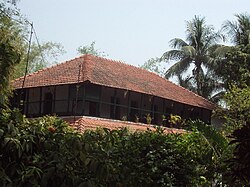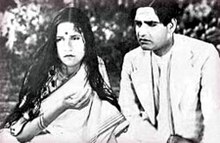Sarat Chandra Chattopadhyay
Sarat Chandra Chattopadhyay | |
|---|---|
 | |
| Born | 15 September 1876 Debanandapur, Hooghly, Bengal, British India |
| Died | 16 January 1938 (aged 61) Kolkata, Bengal, British India |
| Pen name | Anila Devi |
| Occupation | Writer |
| Nationality | British India |
| Citizenship | Indian |
| Period | 19th century-Early 20th century |
| Genre | Novelist |
| Literary movement | Bengal Renaissance |
| Spouse | Shanti devi(deceased in plague in Burma), Hironmoyi devi (previously called Mokkhoda) |
| Children | One boy, who died in the Burma plague as a baby |
Sarat Chandra Chattopadhyay (Bengali: শরৎচন্দ্র চট্টোপাধ্যায়)[1] (15 September 1876 – 16 January 1938) is one of the most popular Bengali novelists and short story writers of early 20th century.
Background and writing
Sarat Chandra was born into poverty in Debanandapur, Hooghly, India. His family was occasionally supported by other family members and Sarat Chandra's lack of financial stability would influence his writing in years to come. He started his education at "Pyari Pandit"s" pathshala and then he took admission at Hooghly Branch High School. Although he began as a fine arts student, Chattopadhyay left his studies due to his persistent state of poverty. He received his early education while residing at his maternal uncle's house in Bhagalpur. He spent 20 years of his life in Bhagalpur and a significant portion of his novels were either written in Bhagalpur or based on his experience in Bhagalpur.
His work represented rural Bengali society and he often wrote against social superstitions and oppression. For a short period he was a sannyasi, a Hindu ascetic who abandons the material and social worlds. His first published story was "Mandir". He was particularly sensitive to the cause of women.
After the death of his parents Sarat Chandra left his college education midway and went to Burma in 1903. There he found employment with a Government Office as clerk. He did not remain at his job in Burma for long and decided to return to his homeland but before his departure he submitted a short story for a prize competition under his uncle's name, Surendranath Ganguli. It won first prize in 1904.
Sarat Chandra's biography is available in Hindi, written by a well-known author, Vishnu Prabhakar. Prabhakar traveled for fourteen years continuously to collect material for this book.
Though he was always known to be an intrepid champion of the marginalized when it comes to novels, personally he was always a shy and private person. There was an occasion when his name was already announced and he was supposed to meet his readers but he left and the curtain was raised on an empty stage.
He died in Kolkata of liver cancer in 1938.
House of Sarat Chandra Chattopadhyay


After returning from Burma, Chattopadhyay stayed for 11 years in Baje Shibpur, Howrah. Then he made a house in the village of Samtabere. He spent the later years of his lifetime as a novelist in Samtabere and in another house in Kolkata. His house in Samtaber is often called by and shown as Sarat Chandra Kuthi (Bengali: শরত্চন্দ্র কুঠী) in the map of Samtaber or Samta, in the Howrah district of West Bengal.

The Rupnarayan River then used to flow right outside the window of Sarat Chandra’s ground floor study. Now, the river has changed its route and has moved far away. The two storied Burmese style house was also home to Sarat Chandra's brother, Swami Vedananda, who was a disciple of Belur Math. His along with his brother Swami Vedananda's samadhi can still be seen there. Swami Vedananda was a disciple in Belur Math. The trees like that of bamboo, galoncho and the guava trees planted by the renowned author are still tourist attractions.[2]


Parts of the house-like the mud-walled kitchen-collapsed and the house was damaged in the 1978 floods, the Zilla Parishad undertook its repair spending ₹77000. After it was declared as a Heritage or Historical Site by the Clause 2 of the West Bengal Heritage Commission Act 2001 (Act IX of 2001)[3][4] Act IX of 2001 in 2009 the whole house was renovated and the belongings of Sarat Chandra like his furniture, walking stick, shoes etc. were polished and are restored in showcases. The tress which was almost going to fall down and die was given proper care and support. The house’s boundary has been extended until the Samadhis, surrounding them which earlier used to lie on the road. Except these tress have been planted around the house which add to its beauty.
Sarat Mela
Sarat Mela is an annual fair which is held in late January every year for seven days to showcase the different lifetimes of Sarat Chandra. The fair is solely dedicated to Sarat Chandra and his works. Sarat Mela was started in 1972. Complete with countless stalls of handicrafts and local products, giant wheels, merry-go-rounds, stalls of jalebi, papad, toys, utensils, etc. Cultural programs mostly held by local talents, debate and singing competition is also held. Students display their handicrafts as do amateur and professional gardeners. They also display unique like over-sized vegetables and plants, series of terracotta relief plaques depicting the various phases of Sarat Chandra’s life like his childhood, his marriage, his homeopathic clinic for the poor, his last journey to Kolkata’s Park Nursing Home in a palanquin and so on which catch the eye. Also such clay “illustrations” of Sarat Chandra’s works like Mahesh are installed. The fair ends late at night with Chhau dance and a fireworks display.
The fair is held on the Panitras High School grounds some distance from Sarat Chandra’s house but if it could be shifted to the open space where the Rupnarayan River once flowed right in front of the house people could link the two more easily. The Government of West Bengal does not provide funds, only private and public donations allow the villagers to hold the fair. However, sometime the number of people it draws is reduced due to unpleasant weather conditions like rainfall.
Works

- Bordidi, (The Elder Sister) 1907
- Bindur Chhele, (Bindu's Son) 1913
- Parinita/Parineeta, 1914
- Biraj Bou, (Mrs. Biraj) 1914
- Ramer Shumoti, (Ram Returning to Sanity) 1914
- Palli Shomaj, 1916
- Arakhsanya, 1916
- Debdas/Devdas, 1917 (written in 1901)
- Choritrohin, (Characterless) 1917
- Srikanto, (4 parts, 1917, 1918, 1927, 1933)
- Datta, 1917–19
- Grihodaho, 1919
- Dena Paona, (Debts and Demands) 1923
- Pather Dabi, (Demand for a Pathway) 1926
- Ses Prasna, (The Final Question) 1931
- Bipradas, 1935
- Nishkriti
- Mej Didi
- Chandranath
- Bilashi
- Mandir
- Pandit Mashay
- Dhare Alo
- Naba Bidhan
- Shesher Parichoy
- Boikunter Will
- Shubhoda
- Swami (The Husband)
- Ekadoshi Bairagi
- Mahesh (The Drought)
- Anuradha
- Anupamar Prem
- Andhare Aalo
- Dorpochurno (Broken Pride)
- Harilakshmi
- Kashinath
- Abhagir Swargo
- Aalo O Chhaya
- Sharda (published posthumously)
Films

His works have been made into some fifty films in many Indian languages,[5] particularly his novel Devdas made into eight versions, from Bengali, Hindi to Telugu, Parineeta also been made twice, Majhli Didi (1967) by Hrishikesh Mukherjee and Swami (1977) for which he was awarded Filmfare Award for Best Story. Another famous film Chhoti Bahu (1971) is based on his novel Bindur Chhele.His Novel 'Datta' was adapted into a Bengali film (1976) starring Suchitra Sen and Soumitra Chatterjee in the lead roles.
There was another movie based on his novel called Nishkriti, Apne Paraye (1980) by Basu Chatterjee, starring Amol Palekar.[6] The Telugu film Thodi Kodallu (1957) is also based on this novel. Gulzar's 1975 film, Khushboo is majorly inspired by his work entitled Pandit Mashay. The 1961 Telugu film Vagdanam by Acharya Atreya is loosely based on his novel Datta. Also the 2011 film Aalo Chhaya is based on his short story, Aalo O Chhaya.
Awards and degrees
- Kuntolin puraskar (For Mandir)
- D-Lit (Given by University of Dhaka, now in Bangladesh)
Textbooks
- Golpo Songroho (Collected Stories), the national text book of B.A. (pass and subsidiary) course of Bangladesh, published by University of Dhaka in 1979 (reprint in 1986).
- Bangla Sahitya (Bengali Literature), the national text book of intermediate (college) level of Bangladesh published in 1996 by all educational boards.
See also
- Films based on works by Sarat Chandra Chattopadhyay.
- Samtaber, the village where Sarat Chandra spent his life's early years as a novelist.
- Sarat Chandra Kuthi, the house of Sarat Chandra at Samtaber.
References
- ^ alternatively spelt as Sarat Chandra Chatterjee
- ^ House of Sarat Chandra
- ^ Origin of W.B. Heritage Commission
- ^ West Bengal Heritage Commission Act 2001 (Act IX of 2001)
- ^ Sarat Chandra Chattopadhyay at IMDb
- ^ Gulzar (2003). Encyclopaedia of Hindi Cinema. Popular Prakashan. p. 337. ISBN 81-7991-066-0.
{{cite book}}: Unknown parameter|coauthors=ignored (|author=suggested) (help)
General
- Ganguly, Swagato. "Introduction." In Parineeta by Saratchandra Chattopadhyay. New Delhi: Penguin Books, 2005. (English translation)
- Guha, Sreejata. "Introduction." In Devdas by Saratchandra Chattopadhyay. New Delhi: Penguin Books, 2002. (English translation)
- Roy, Gopalchandra. Saratchandra, Ananda Publishers Pvt. Ltd., Kolkata
- Sarat Rachanabali, Ananda Publishers Pvt. Ltd., Kolkata
- Prithwindra Mukherjee. "Introduction" in Mahesh et autres nouvelles by Saratchandra Chatterji. Paris: Unesco/Gallimard, 1978. (French translation of Mahesh, Bindur chhele and Mejdidi by Prithwindra Mukherjee. Foreword by Jean Filliozat)
- Online web portal: http://sarat-rachanabali.becs.ac.in
External links
- An Evaluation of Saratchandra
- Biographies
- Banglapedia biography
- Bengalonline biography
- Calcuttaweb biography
- Sharat Chandra Chattopadhyay at IMDb
- भारतीय साहित्य संग्रह में शरत् साहित्य
- www.independentindian.com
- Articles
